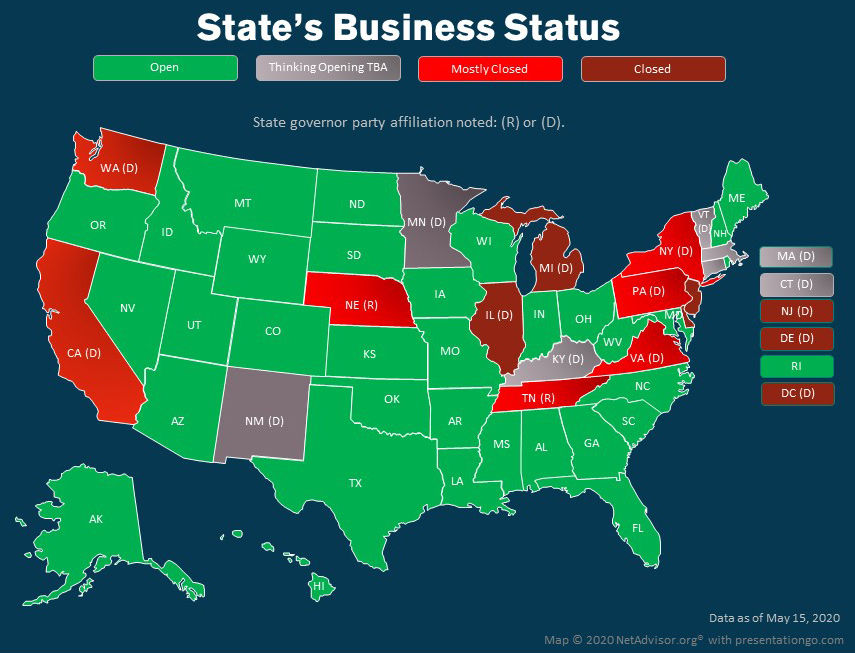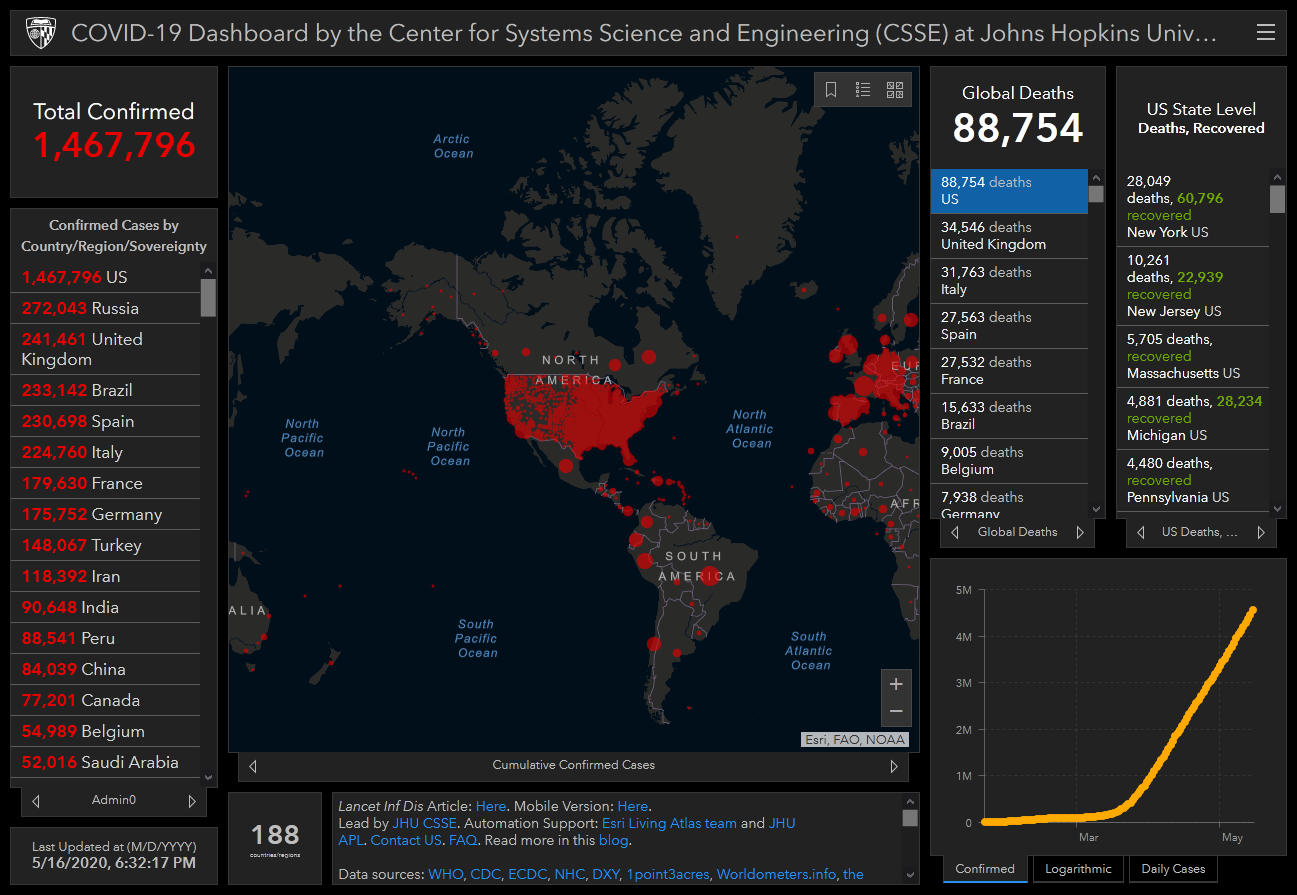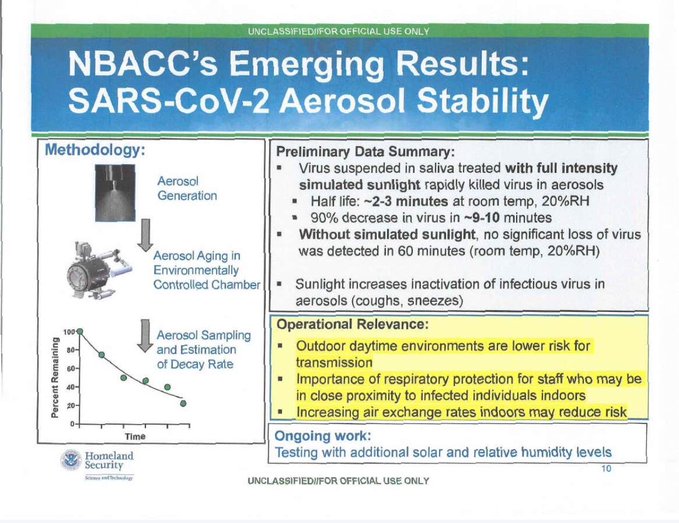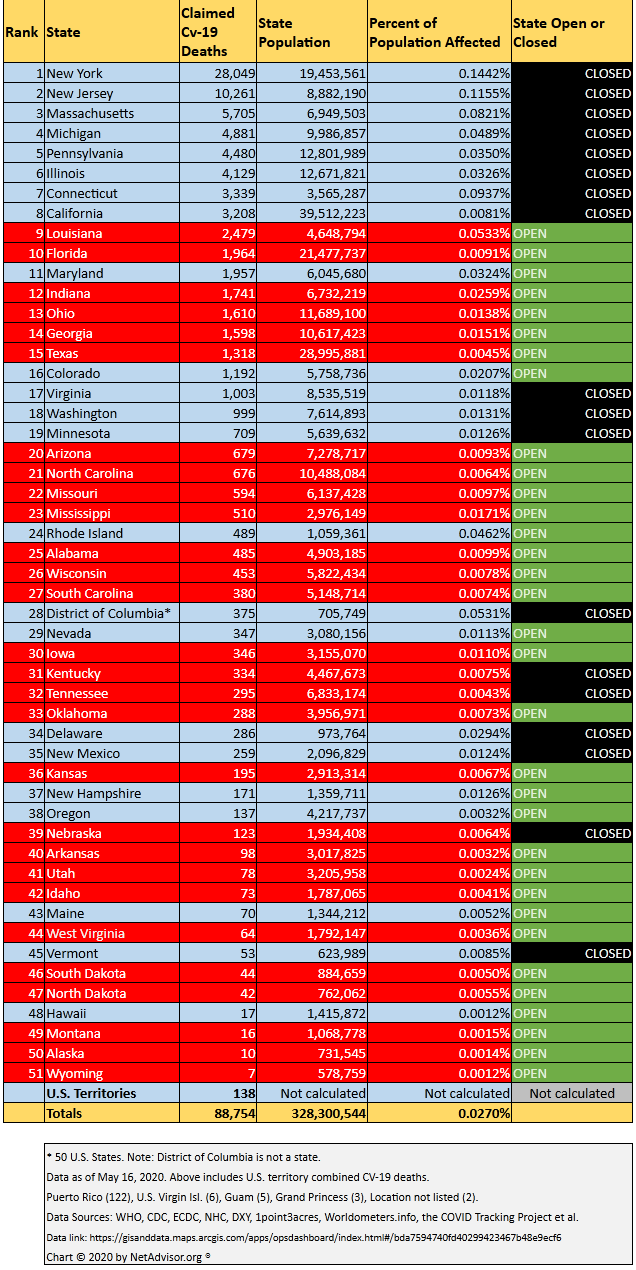May 17, 2020

GREY areas are states that are thinking about opening up or partially opening up soon.
LIGHT RED areas have limited openings such as curb-side business. Overall, we view the state as highly restricted to mostly closed.
DARK RED areas are looking to go bankrupt. Their state is closed with the non-criminal population effectively in prison; while many that were actually in the prison population, may have been released from prison by the same state governor.
- Outdoor Sunlight Can Reduce Coronavirus Transmission – DHS Study.
written by Net Advisor™
WASHINGTON, DC. We recently discussed how elderly in nursing homes, especially those with underline health issues had concentrated impact from Coronavirus. How did the rest of the country fair thus far? What states are open for business and what states are still resisting business?

Coronavirus Analysis.
We literately copied the data from (what we call), the Coronavirus Assault Map (above) into a spread sheet and then did some math. This is the map that basically everyone in the media likes to use.
We captured a still shot of U.S. population numbers, to figure out the ratio of CV-19 deaths to population. Then we did some basic math by dividing the number of stated CV-19 deaths into each state’s population. The result gave us the percentage of deaths relative to each state’s population. We also included the District of Columbia which is not a state; and combined U.S. territories who reported CV-19 deaths on a separate line (table below).
This is What We Found:
Oddly enough, the biggest Coronavirus death risks seem to be concentrated in Democratic states.
Democrat States Unfairly Targeted by Coronavirus?
We found that the top 8 states with the most Coronavirus deaths are Democrat-controlled states. Some may argue: ‘We’ll, those states have more population so they will have more deaths.’
If that was true, California would have the most deaths by population, but is ranked #8 in Coronavirus deaths. Texas is the second most populated state and is ranked #15 in Coronavirus deaths.
Florida has the 3rd largest population, and it is ranked #10 in Coronavirus deaths.
North Carolina has a greater population than the #2, 3, 4, 7, 9, 11, 12, 16, 17, 18, 19 and #20 states (table below), and North Carolina has far fewer Coronavirus deaths with a greater population than the said 12 other states (See table below for state ranking).
The current data shows that the top 8 states with the most Coronavirus deaths are all (D) states, and account for 72.17% of all Coronavirus deaths in the United States.
— NetAdvisor analysis using WHO, CDC, et al., Covid-19 tracking data as of May 16, 2020.
The current data shows that the top 8 states with the most Coronavirus deaths are all (D) states, and account for 72.17% of all Coronavirus deaths in the United States. [Math: 64,052 CV19 deaths (top 8 states) divided into 88,754 total number CV19 deaths in USA = .72168 or 72.17% (math rounding to nearest whole number).
Odds of Dying From Coronavirus – Very Low.
We then factored state population by looking at the odds of one actually dying from Coronavirus in all 50 states and DC. The state that has the highest death risk by percentage of population is New York, where 0.14% of the population has died from Coronavirus. That’s still not even one percent.
New York Leaders Side With Politics Over People & Police
New York has the most Coronavirus deaths so far. The state lock-down did somehow put New York #1 in Coronavirus deaths despite being the #4 most populated state.
We previously discussed that New York’s leaders all resisted concerns about Coronavirus. They were against President Trump’s January 2020 travel ban with China.
NY leadership encouraged people to mass gather in February for the China Lunar New Year in New York. The City Commissioner, a medical doctor mind you, called the Coronavirus as “misinformation.”
NY leadership further chastised their own police department denying additional PPE equipment.
Their governor sent elderly people with Coronavirus to infect others which resulted in record deaths.
Check out those NY article links, and then one will have a very clear understanding why New York has record Coronavirus deaths.
On to Other States.
Vermont, probably the most paranoid state in the country; has a population less than 1/10th of Los Angeles; and thus far has only 44 Coronavirus deaths, representing 0.0085% of the state’s population.
So few people have died in Vermont, it’s statistically not worth counting. In fact, one is more likely to die in a car crash in Vermont than die from Coronavirus (NHTSA, P9, Table 7).
Vermont is represented by Senator Bernie Sanders (I) and Patrick Leahy (D). The reason why we pick on Vermont here is because the state’s leaders have kept the state closed.
Vermont currently has a “Republican” governor. But don’t be fooled. Technically, the Vermont governor is deemed a “liberal” Republican and supported the impeachment of President Trump. We colored the state gray in our map (above) because the state has a (D)-Controlled House, a (D)-Controlled Senate, leans (D) in general elections, and the governor leans politically Left.
Speaking of car crashes, there are many other states that one is more likely to die in a car crash than from Coronavirus. See NHTSA, P9, Table 7.
The states with the lowest death risks of Coronavirus by population thus far have been in this order: Wyoming (R) and Hawaii (D) tied (.0012%); Alaska (R) (.0014%), then Montana (R) (.0015%).
Take a look at the chart below and check out your state!
For those who need to know, blue are the politically left leaning states, and red are politically right leaning states. We also gave a net overall rating of (state) open or closed for business in the table below. There are 15 states still shutdown, 12 “Blue (D)” states and 3 “Red (R)” states. For more details of state status, please see the map at the top of this page.
Did you notice the last line in the above chart – Totals. Based on the entire U.S. state population (includes DC and U.S. territories), the math works out (statistically speaking) – a 99.9973% chance one is unlikely to die from Coronavirus. (Math: 100 – .027 = 99.973).
Counter Argument.
Sure, we unfortunately will see more Coronavirus deaths, and people will die from all kinds of other things too – and in far greater numbers. But the data is not as dire as we were made to believe.
Now will come the, ‘we’ll that’s because of quarantine!’
Really? How do we know that?
‘Because people stayed inside!’
Everybody? That didn’t work well for all the people who stayed inside nursing homes?
Who was the control group (science) to compare this data too? Oh, there was no control group (city or state) to statistically compare risks of being confined indoors, versus the risk of being outdoors and self-monitored?
We’ll maybe there was some sort of control group.
South Dakota – A Control Group?
South Dakota was the only state who never officially shut down. The governor, Kristi Noem (R), made suggestions about social distancing and safe practices including hand washing, but no unilateral executive orders of confinement and shutting down businesses throughout the state, as many governors did.
The governor felt that people and business were grownup adults, and they alone should decide what is best for them and take appropriate actions. South Dakota is currently ranked #46 of 50 having the least amount of Coronavirus deaths at just 44.
South Dakota has a population of about 884,659 people. Compare this population to say Washington DC’s population of 705,749.
Washington DC has over EIGHT TIMES more deaths (375) than South Dakota [Math: 44 (the number of SD CV19 deaths) x 8 = 352 (number CV19 deaths in DC is 375)].
Hence, Washington DC has a smaller population, yet over 8 times the death rate of South Dakota, and DC is still shutdown. For those interested in the politics, South Dakota is completely run by Republicans. Washington DC is not a state and is currently ran by Mayor Muriel Bowser (D) and its city council has 10 (D), 2 (I) and zero (R).
Naturally (again), the virus is ongoing and the above data will change. The probability is that more people will unfortunately become ill, and some may not survive. Keep in mind these unfortunate deaths are still a tiny fraction of the population; and those over 65 and with compromised immune systems are the most at risk.
However, local and regional officials shutting down major city or state economies for even just four to six plus months is financial suicide.
Despite these facts, certain local and state governments continue to lock down their citizens in home detention. It seems that one of the best solutions to reduce Coronavirus transmission is outdoor sunlight.
DHS – Outdoor (Sunlight): LOWER Risk of Coronavirus Transmission.
The Department of Homeland Security tested various conditions of how Coronavirus lives. It seems the best way to reduce chances of CV-19 infection is to be in outdoor sunlight.
DHS Chart:

Note again Hawaii (tied with Wyoming) for the lowest Coronavirus deaths based on their population ratio. Who in Hawaii or Wyoming never venture outdoors?
Yet, certain cities, counties and states still insist to keep people indoors – in order to keep them safe?
Images/ graphic may be copyright by their respective owners.
Original article content, Copyright © 2020 NetAdvisor.org® All Rights Reserved.
NetAdvisor.org® is a non-profit organization providing public education and analysis primarily on the U.S. financial markets, personal finance and analysis with a transparent look into U.S. public policy. We also perform and report on financial investigations to help protect the public interest. Read More.


